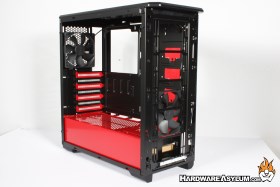Phanteks Eclipse P400 Tempered Glass Edition Case Review
Author: Dennis GarciaCase Venting and Cooling Layout
The Phanteks Eclipse P400 features locations for a total of six 120mm fans at the front, top and back of the case. These locations also support 140mm fans with a total of four supported at the top and front of the case. Getting these fans to breathe can be a challenge and is something I believe the P400 is equipped to handle.
Starting at the top of the case you’ll find a magnetic fan filter covering the top mounted fan locations. I would consider these to be a secondary exhaust and while you don’t need to filter exhaust air it is nice to have a way to cover the stamped metal holes.
At the bottom of the case you’ll find a much larger filter covering the intake for the power supply along with four rather small feet used to lift the case and provide some stability and airflow to the PSU.
The front of the P400 supports three 120mm fans which are covered by a folded steel front bezel. This bezel features two hidden vents at the top and bottom and is held in place with ball style friction clips for easy removal.
Each vent comes with a small fine mesh dust filter that just feels undersized for any system using more than a single 120mm case fan. They are easy to access and clean which is something I suspect you will be doing every couple weeks.
Of course with the case apart you can get a good idea as to where the cooling fans are located. The P400 comes with two 120mm fans, one in the front and one in the back. For most builds this is all you will need but, that is no fun.
To accommodate a variety of different cooling configurations you will find two sets of mounting slots for 120mm and 140mm cooling fans. The slots not only allow for custom fan positions but also give you support for a variety of radiators and the ability to move the radiator around depending on your hardware requirements.
For instance if your AIO has short hoses or to better align your DIY loop for maximum squareness.







